Seat Mii 2017 Owner's manual
Manufacturer: SEAT, Model Year: 2017, Model line: Mii, Model: Seat Mii 2017Pages: 232, PDF Size: 4.91 MB
Page 211 of 232
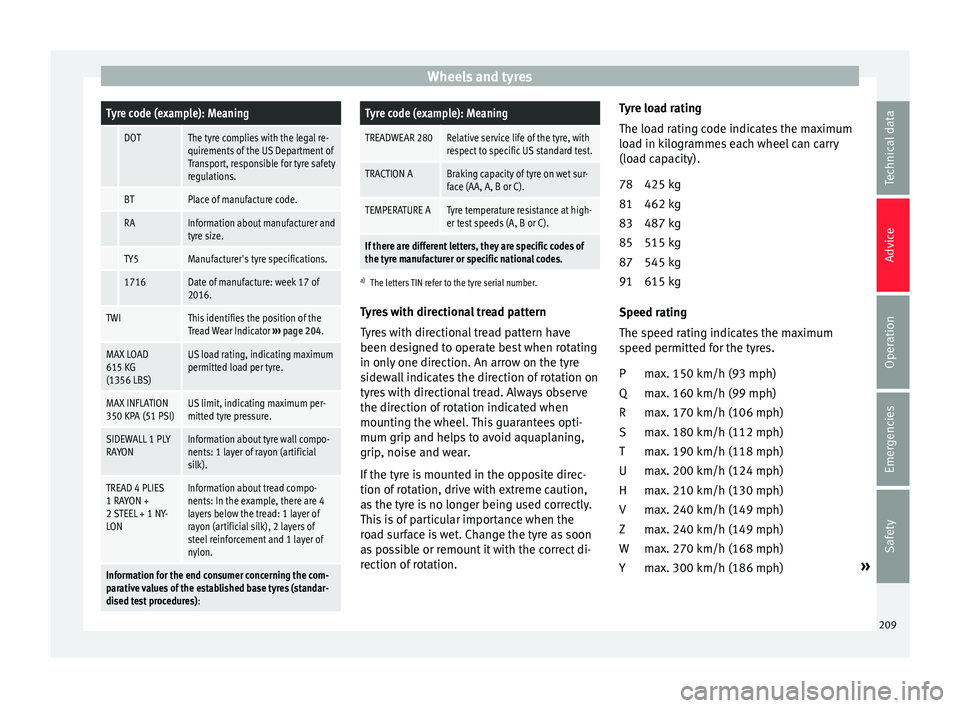
Wheels and tyresTyre code (example): Meaning
DOTThe tyre complies with the legal re-
quirements of the US Department of
Transport, responsible for tyre safety
regulations.
BTPlace of manufacture code.
RAInformation about manufacturer and
tyre size.
TY5Manufacturer's tyre specifications.
1716Date of manufacture: week 17 of
2016.
TWIThis identifies the position of the
Tread Wear Indicator
››› page 204.
MAX LOAD
615 KG
(1356 LBS)US load rating, indicating maximum
permitted load per tyre.
MAX INFLATION
350 KPA (51 PSI)US limit, indicating maximum per-
mitted tyre pressure.
SIDEWALL 1 PLY
RAYONInformation about tyre wall compo-
nents: 1 layer of rayon (artificial
silk).
TREAD 4 PLIES
1 RAYON +
2 STEEL + 1 NY-
LONInformation about tread compo-
nents: In the example, there are 4
layers below the tread: 1 layer of
rayon (artificial silk), 2 layers of
steel reinforcement and 1 layer of
nylon.
Information for the end consumer concerning the com-
parative values of the established base tyres (standar-
dised test procedures) :
Tyre code (example): Meaning
TREADWEAR 280Relative service life of the tyre, with
respect to specific US standard test.
TRACTION ABraking capacity of tyre on wet sur-
face (AA, A, B or C).
TEMPERATURE ATyre temperature resistance at high-
er test speeds (A, B or C).
If there are different letters, they are specific codes of
the tyre manufacturer or specific national codes.
a)
The letters TIN refer to the tyre serial number.
Tyres with directional tread pattern
Tyres with directional tread pattern have
been designed to operate best when rotating
in only one direction. An arrow on the tyre
sidewall indicates the direction of rotation on
tyres with directional tread. Always observe
the direction of rotation indicated when
mounting the wheel. This guarantees opti-
mum grip and helps to avoid aquaplaning,
grip, noise and wear.
If the tyre is mounted in the opposite direc-
tion of rotation, drive with extreme caution,
as the tyre is no longer being used correctly.
This is of particular importance when the
road surface is wet. Change the tyre as soon
as possible or remount it with the correct di-
rection of rotation. Tyre load rating
The load r
ating code indicates the maximum
load in kilogrammes each wheel can carry
(load capacity).
425 kg
462 kg
487 kg
515 kg
545 kg
615 kg
Speed rating
The speed rating indicates the maximum
speed permitted for the tyres. max. 150 km/h (93 mph)
max. 160 km/h (99 mph)
max. 170 km/h (106 mph)
max. 180 km/h (112 mph)
max. 190 km/h (118 mph)
max. 200 km/h (124 mph)
max. 210 km/h (130 mph)
max. 240 km/h (149 mph)
max. 240 km/h (149 mph)
max. 270 km/h (168 mph)
max. 300 km/h (186 mph) »
78
81
83
85
87
91
P
Q
R
S
T
U
H
V
Z
W
Y
209
Technical data
Advice
Operation
Emergencies
Safety
Page 212 of 232
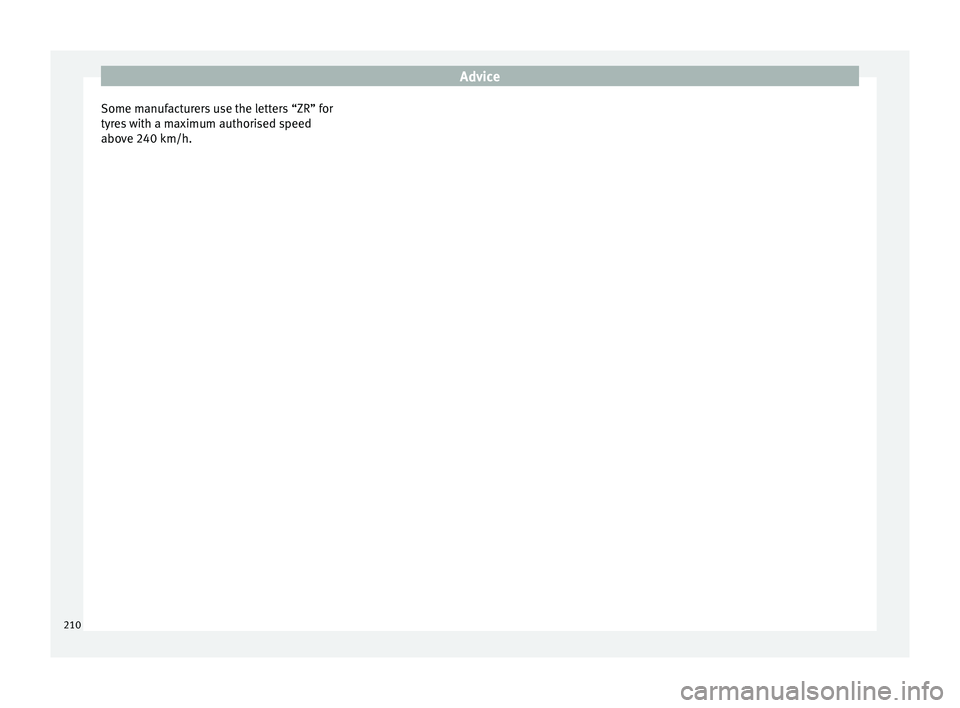
Advice
Some manufacturers use the letters “ZR” for
ty r
e
s with a maximum authorised speed
above 240 km/h.
210
Page 213 of 232

Technical features
Technical data
T ec
hnic
al features
Important information Introduction The information in the vehicle documentation
alwa
y
s takes precedence over the informa-
tion in this Instruction Manual.
All technical specifications provided in this
documentation are valid for the standard
model in Spain. The vehicle data card inclu-
ded in the Maintenance Programme or the
vehicle registration documents shows which
engine is installed in the vehicle.
The figures may be different depending
whether additional equipment is fitted, for
different models, for special vehicles and for
other countries. Abbreviations used in the Technical Specifi-
cation
s
section
kWKilowatt, engine power measurement.
PSPferdestärke (horsepower), formerly
used to denote engine power.
rpmRevolutions per minute - engine speed.
NmNewton metres, unit of engine torque.
CZCetane number, indication of the diesel
combustion power.
RONResearch octane number, indication of
the knock resistance of petrol. Vehicle identification data
Fig. 179
Vehicle data label. Fig. 180
Vehicle identification number. Vehicle identification number
The
v
ehic
le identification number (chassis
number) can be read from outside the vehicle
through a viewer in the windscreen
››› Fig. 180. This viewer is located in the lower
part of the windscreen. The vehicle identifica-
tion number (chassis number) is also stam-
ped on the right water drain channel. The wa-
ter drain channel is located between the sus-
pension tower and the wing. Open the bon-
net to read the vehicle identification number
.
Vehicle data plate
The vehicle data label ››› Fig. 179 is at the
front of the spare wheel well. It contains the
following data:
Vehicle identification number (chassis
number).
Vehicle type, engine power, gearbox type. »
1 2
211
Technical data
Advice
Operation
Emergencies
Safety
Page 214 of 232
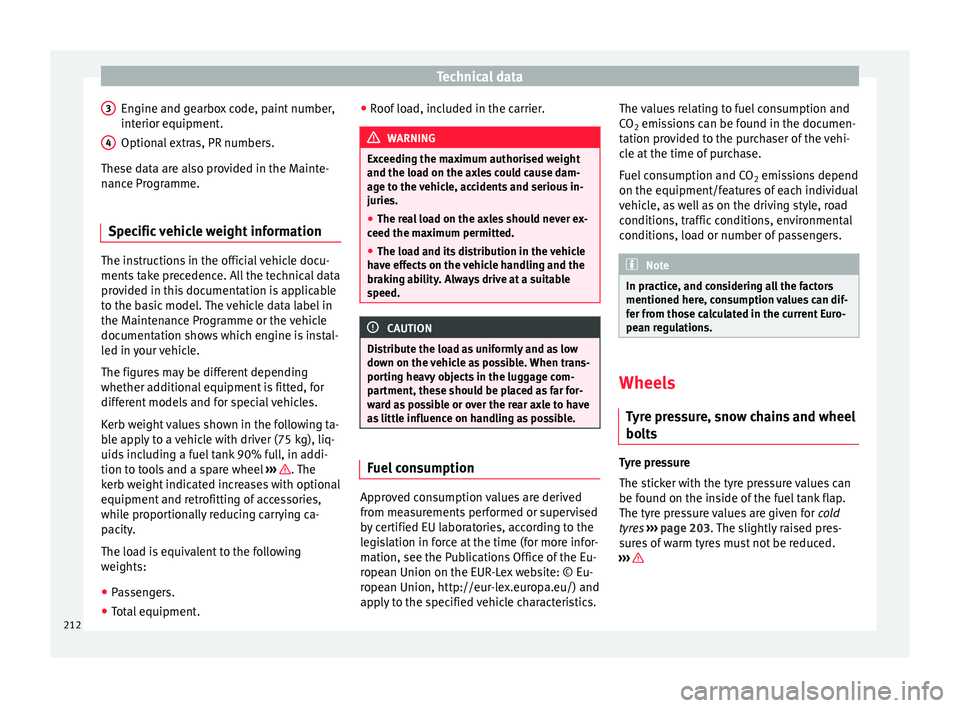
Technical data
Engine and gearbox code, paint number,
int erior equipment
.
Option
al extras, PR numbers.
These data are also provided in the Mainte-
nance Programme.
Specific vehicle weight information The instructions in the official vehicle docu-
ments t
ak
e precedence. All the technical data
provided in this documentation is applicable
to the basic model. The vehicle data label in
the Maintenance Programme or the vehicle
documentation shows which engine is instal-
led in your vehicle.
The figures may be different depending
whether additional equipment is fitted, for
different models and for special vehicles.
Kerb weight values shown in the following ta-
ble apply to a vehicle with driver (75 kg), liq-
uids including a fuel tank 90% full, in addi-
tion to tools and a spare wheel ››› . The
k erb w
eight
indicated increases with optional
equipment and retrofitting of accessories,
while proportionally reducing carrying ca-
pacity.
The load is equivalent to the following
weights:
● Passengers.
● Total equipment.
3 4 ●
Roof
lo
ad, included in the carrier. WARNING
Exceeding the maximum authorised weight
and the loa d on the ax
les could cause dam-
age to the vehicle, accidents and serious in-
juries.
● The real load on the axles should never ex-
ceed the max
imum permitted.
● The load and its distribution in the vehicle
have eff
ects on the vehicle handling and the
braking ability. Always drive at a suitable
speed. CAUTION
Distribute the load as uniformly and as low
down on the v
ehicle as possible. When trans-
porting heavy objects in the luggage com-
partment, these should be placed as far for-
ward as possible or over the rear axle to have
as little influence on handling as possible. Fuel consumption
Approved consumption values are derived
fr
om me
a
surements performed or supervised
by certified EU laboratories, according to the
legislation in force at the time (for more infor-
mation, see the Publications Office of the Eu-
ropean Union on the EUR-Lex website: © Eu-
ropean Union, http://eur-lex.europa.eu/) and
apply to the specified vehicle characteristics. The values relating to fuel consumption and
CO
2 emis
sions can be found in the documen-
tation provided to the purchaser of the vehi-
cle at the time of purchase.
Fuel consumption and CO 2 emissions depend
on the equipment/features of each individual
vehicle, as well as on the driving style, road
conditions, traffic conditions, environmental
conditions, load or number of passengers. Note
In practice, and considering all the factors
mentioned here, c on
sumption values can dif-
fer from those calculated in the current Euro-
pean regulations. Wheels
Ty
r
e pressure, snow chains and wheel
bolts Tyre pressure
The s
tic
k
er with the tyre pressure values can
be found on the inside of the fuel tank flap.
The tyre pressure values are given for cold
tyres ›››
page 203. The slightly raised pres-
sures of warm tyres must not be reduced.
››› 212
Page 215 of 232
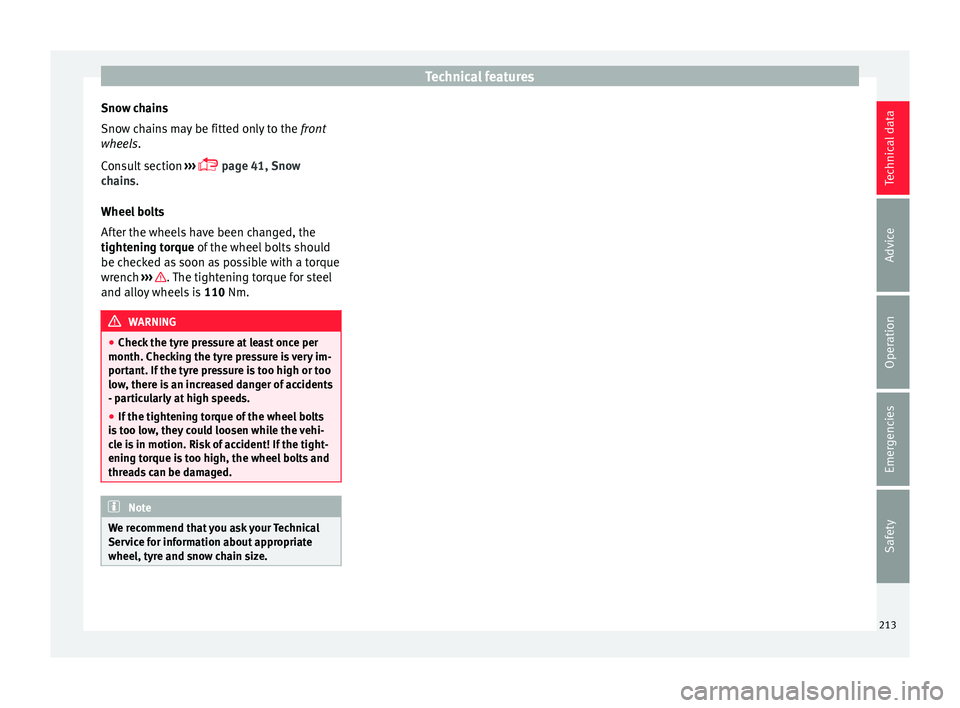
Technical features
Snow chains
Sno w c
h
ains may be fitted only to the front
wheels.
Consult section ›››
page 41, Snow
chains.
Wheel bolts
After the wheels have been changed, the
tightening torque of the wheel bolts should
be checked as soon as possible with a torque
wrench ››› . The tightening torque for steel
and al lo
y
wheels is 110 Nm. WARNING
● Check the ty
re pressure at least once per
month. Checking the tyre pressure is very im-
portant. If the tyre pressure is too high or too
low, there is an increased danger of accidents
- particularly at high speeds.
● If the tightening torque of the wheel bolts
is t
oo low, they could loosen while the vehi-
cle is in motion. Risk of accident! If the tight-
ening torque is too high, the wheel bolts and
threads can be damaged. Note
We recommend that you ask your Technical
Serv ic
e for information about appropriate
wheel, tyre and snow chain size. 213
Technical data
Advice
Operation
Emergencies
Safety
Page 216 of 232

Technical data
Engine data P etr
o
l engine 1.0 44 kW (60 PS) Engine specifications
Power output in kW (PS) at rpmMaximum torque (Nm at rpm)No. of cylinders/displacement (cm
3
)Fuel
44 (60)/5,000-6,00095/3,000-4,3003/999Super 95 ROZ / Normal 91 a)
ROZ
a) Slight power loss.
PerformanceManualEcomotiveStart-Stop
EcomotiveAutomatic
Top speed (km/h)161 (4)161 (4)161 (4)161 (4)
Acceleration from 0-80 km/h (seconds)9.19.110.910.9
Acceleration from 0-100 km/h (seconds)14.414.416.716.7
Weights (in kg)
Gross vehicle weight1,3201,3301,3301,330
Weight in running order (with driver)926934940937
Gross front axle weight680680680680
Gross rear axle weight640640640640
Permitted roof load50505050 214
Page 217 of 232
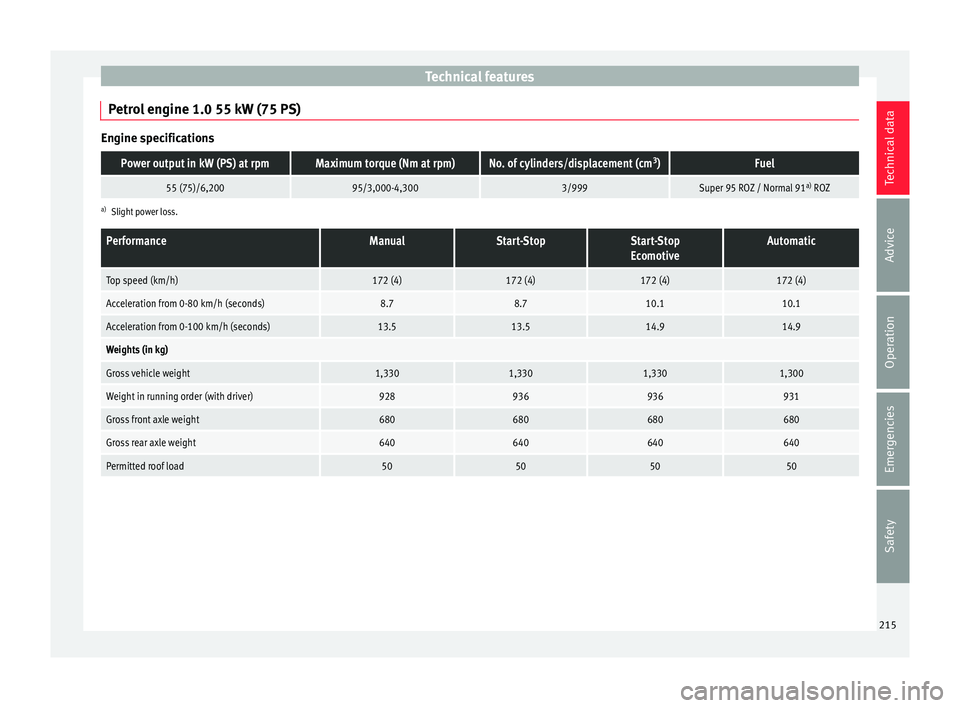
Technical features
Petrol engine 1.0 55 kW (75 PS) Engine specificationsPower output in kW (PS) at rpmMaximum torque (Nm at rpm)No. of cylinders/displacement (cm
3
)Fuel
55 (75)/6,20095/3,000-4,3003/999Super 95 ROZ / Normal 91 a)
ROZ
a) Slight power loss.
PerformanceManualStart-StopStart-Stop
EcomotiveAutomatic
Top speed (km/h)172 (4)172 (4)172 (4)172 (4)
Acceleration from 0-80 km/h (seconds)8.78.710.110.1
Acceleration from 0-100 km/h (seconds)13.513.514.914.9
Weights (in kg)
Gross vehicle weight1,3301,3301,3301,300
Weight in running order (with driver)928936936931
Gross front axle weight680680680680
Gross rear axle weight640640640640
Permitted roof load50505050 215
Technical data
Advice
Operation
Emergencies
Safety
Page 218 of 232

Technical data
Petrol/CNG engine 1.0 50 kW (68 PS) Engine specificationsPower output in kW (PS) at rpmMaximum torque (Nm at rpm)No. of cylinders/capacity (cm
3
)Fuel
50 (68)/6,20090/3,0003/999CNG
Super 95 ROZ / Normal 91 a)
ROZ
a) Slight power loss.
Performance
Top speed (km/h)164 (4)
Acceleration from 0-80 km/h (seconds)10.3
Acceleration from 0-100 km/h (seconds)16.3
Weights (in kg)
Gross vehicle weight1,380
Weight in running order (with driver)1,033
Gross front axle weight680
Gross rear axle weight640
Permitted roof load50 216
Page 219 of 232

Technical features
Dimensions Fig. 181
Dimensions. Mii 3-doorMii 5-door
A/BFront and rear projection (mm)595/542
CWheelbase (mm)2,420
DLength (mm)3,557
E/FFront/rear a)
track width (mm)1,428/1,424
GWidth (mm)1,6411,645
HHeight at kerb weight (mm)1,478
Turning radius (m)approx. 9.8
a) This data will change depending on the type of wheel rim.
217
Technical data
Advice
Operation
Emergencies
Safety
Page 220 of 232
